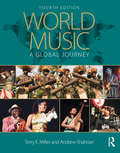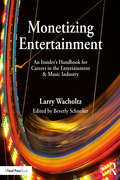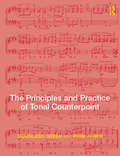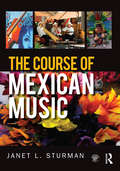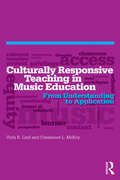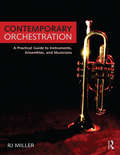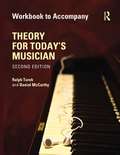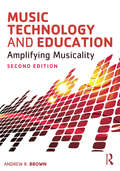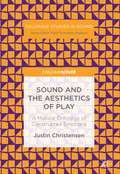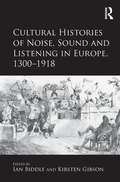- Table View
- List View
World Music: A Global Journey - eBook & mp3 Value Pack
by Terry E. Miller Andrew ShahriariWorld Music: A Global Journey, Fourth Edition takes students around the world to experience the diversity of musical expression and cultural traditions. It is known for its breadth in surveying the world's major cultures in a systematic study of world music within a strong pedagogical framework. As one would prepare for any journey, each chapter starts with background preparation, reviewing the historical, cultural, and musical overview of the region. Visits to multiple "sites" within a region provide in-depth studies of varied musical traditions. Music analysis begins with an experiential "first impression" of the music, followed by an "aural analysis" of the sound and prominent musical elements. Finally, students are invited to consider the cultural connections that give the music its meaning and life. Fourth Edition features: New sites! Plena from Puerto Rico Chuida from China Gagaku from Japan has returned from the Second Edition New "Inside Look" features spotlight distinguished ethnomusicologists such as Dr. Terence Liu, K.S. Resni, Dr. Sumarsam, Dr. Mick Moloney, Walter Mahovlich, Natalie MacMaster, and Gilbert Velez Addition of DANCE, inseparable to musical expression in some cultures Updates as needed, resulting from various changes in culture, politics, and war New and revised test questions, new photos, and other revised resources The dynamic companion website hosts interactive listening guides plus many student and instructor resources. A set of three CDs is available, with over three hours of diverse music examples necessary to the study. PURCHASING OPTIONS Print Paperback Pack - Book and CD set: 9781138911277 Print Hardback Pack - Book and CD set: 9781138911284 Audio CD: 9781138697805 eBook Pack - eBook and mp3 file: 9781315692791* *See VitalSource.com for various eBook options (mp3 audio compilation not available for separate sale)
Monetizing Entertainment: An Insider's Handbook for Careers in the Entertainment & Music Industry
by Larry WacholtzMonetizing Entertainment: An Insider's Handbook for Careers in the Entertainment & Music Industry offers a thorough, guided exploration of the current state of the industry, with an emphasis on trends in copyright, digital streaming, and practical advice for developing a career as an artist, technician, or industry executive. This book investigates a variety of topics within the entertainment and music industry, ranging from traditional and emerging business models to intellectual property rights to the creative destruction happening currently. The book strategically outlines the existing gaps that make being successful as an artist a dynamic interaction between creativity and business. This book includes the following: An overview of the creative destruction process that has destroyed some of the old business models and created a number of career options. A look at innovative, entrepreneurial career options. A step-by-step examination for both creative and business professionals of the administrative and financial structures of the industry. Detailed analysis of trends and topics shaping the current entertainment and music industry drawn from insiders' perspectives and other contemporary resources. An accompanying website (www.routledge.com/cw/wacholtz), hosting case studies, videos, data, infographics, and blog posts on business models, is the perfect companion to this authoritative resource.
The Principles and Practice of Tonal Counterpoint
by Evan JonesThe Principles and Practice of Tonal Counterpoint is a comprehensive textbook that combines practical, "how-to" guidance in 18th-century techniques with extensive historical examination of contrapuntal works and genres. Beginning with an introductory grounding in species counterpoint, tonal harmony, and figured bass, students progress through the study of chorale preludes, invertible counterpoint, and canonic and fugal writing. This textbook thoroughly joins principle with practice, providing a truly immersive experience in the study of tonal counterpoint and familiarizing students with contrapuntal styles from the Baroque period to the 21st century. Also available is a companion volume, The Principles and Practice of Modal Counterpoint, which focuses on 16th-century techniques and covers modal music from Gregorian chant through the 17th century.
The Course of Mexican Music
by Janet SturmanThe Course of Mexican Music provides students with a cohesive introductory understanding of the scope and influence of Mexican music. The textbook highlights individual musical examples as a means of exploring the processes of selection that led to specific musical styles in different times and places, with a supporting companion website with audio and video tracks helping to reinforce readers' understanding of key concepts. The aim is for students to learn an exemplary body of music as a window for understanding Mexican music, history and culture in a manner that reveals its importance well beyond the borders of that nation.
Culturally Responsive Teaching in Music Education: From Understanding to Application
by Vicki R. Lind Constance McKoyCulturally Responsive Teaching in Music Education presents teaching methods that are responsive to how different culturally specific knowledge bases impact learning. It is a pedagogy that recognizes the importance of including students’ cultural references in all aspects of learning. Designed to be a supplementary resource for teachers of undergraduate and graduate music education courses, the book provides examples in the context of music education, with theories presented in Section I and a review of teaching applications in Section II. Culturally Responsive Teaching in Music Education is an effort to answer the question: How can I teach music to my students in a way that is culturally responsive? This book serves several purposes, by: • Offering theoretical/philosophical frameworks of social justice • Providing practical examples of transferring theory into practice in music education • Illustrating culturally responsive pedagogy within the classroom • Demonstrating the connection of culturally responsive teaching to the school and larger community
Focus: Music in Contemporary Japan (Focus on World Music Series)
by Jennifer Milioto MatsueFocus: Music in Contemporary Japan explores a diversity of musics performed in Japan today, ranging from folk song to classical music, the songs of geisha to the screaming of underground rock, with a specific look at the increasingly popular world of taiko (ensemble drumming). Discussion of contemporary musical practice is situated within broader frames of musical and sociopolitical history, processes of globalization and cosmopolitanism, and the continued search for Japanese identity through artistic expression. It explores how the Japanese have long negotiated cultural identity through musical practice in three parts: Part I, "Japanese Music and Culture," provides an overview of the key characteristics of Japanese culture that inform musical performance, such as the attitude towards the natural environment, changes in ruling powers, dominant religious forms, and historical processes of cultural exchange. Part II, "Sounding Japan," describes the elements that distinguish traditional Japanese music and then explores how music has changed in the modern era under the influence of Western music and ideology. Part III, "Focusing In: Identity, Meaning and Japanese Drumming in Kyoto," is based on fieldwork with musicians and explores the position of Japanese drumming within Kyoto. It focuses on four case studies that paint a vivid picture of each respective site, the music that is practiced, and the pedagogy and creative processes of each group. The accompanying CD includes examples of Japanese music that illustrate specific elements and key genres introduced in the text. A companion website includes additional audio-visual sources discussed in detail in the text. Jennifer Milioto Matsue is an Associate Professor at Union College and specializes in modern Japanese music and culture.
Focus: Scottish Traditional Music (Focus on World Music Series)
by Simon McKerrellFocus: Scottish Traditional Music engages methods from ethnomusicology, popular music studies, cultural studies, and media studies to explain how complex Scottish identities and culture are constructed in the traditional music and culture of Scotland. This book examines Scottish music through their social and performative contexts, outlining vocal traditions such as lullabies, mining songs, Scottish ballads, herding songs, and protest songs as well as instrumental traditions such as fiddle music, country dances, and informal evening pub sessions. Case studies explore the key ideas in understanding Scotland musically by exploring ethnicity, Britishness, belonging, politics, transmission and performance, positioning the cultural identity of Scotland within the United Kingdom. Visit the author's companion website at http://www.scottishtraditionalmusic.org/ for additional resources.
Contemporary Orchestration: A Practical Guide to Instruments, Ensembles, and Musicians
by R. J. MillerContemporary Orchestration: A Practical Guide to Instruments, Ensembles, and Musicians teaches students how to orchestrate for a wide variety of instruments, ensembles, and genres, while preparing them for various real-world professional settings ranging from the concert hall to the recording studio. Unlike most orchestration texts, it includes coverage of contemporary instruments and ensembles alongside traditional orchestra and chamber ensembles. Features Practical considerations: Practical suggestions for choosing a work to orchestrate, and what to avoid when writing for each instrument. Pedagogical features In the Profession: Professional courtesies, considerations and expectations. Building the Score: Step-by-step construction of an orchestration. Scoring Examples: Multiple scoring examples for each instrument. Exercises: Analyzing, problem solving, and creating orchestration solutions. Critical Thinking: Alternate approaches and solutions.
Contemporary Orchestration: A Practical Guide to Instruments, Ensembles, and Musicians
by R. J. MillerContemporary Orchestration: A Practical Guide to Instruments, Ensembles, and Musicians teaches students how to orchestrate for a wide variety of instruments, ensembles, and genres, while preparing them for various real-world professional settings ranging from the concert hall to the recording studio. Unlike most orchestration texts, it includes coverage of contemporary instruments and ensembles alongside traditional orchestra and chamber ensembles. Features Practical considerations: Practical suggestions for choosing a work to orchestrate, and what to avoid when writing for each instrument. Pedagogical features In the Profession: Professional courtesies, considerations and expectations. Building the Score: Step-by-step construction of an orchestration. Scoring Examples: Multiple scoring examples for each instrument. Exercises: Analyzing, problem solving, and creating orchestration solutions. Critical Thinking: Alternate approaches and solutions.
Theory for Today's Musician Workbook, Second Edition (eBook)
by Ralph Turek Daniel McCarthyThe package (ISBN 978-0-415-73036-5) contains the second edition of Theory for Today’s Musician (ISBN: 978-0-415-66332-8) and the Theory for Today’s Musician Workbook (ISBN: 978-0-415-66333-5). The package is available for print books only. Ebook users should purchase the textbook and workbook separately. This workbook accompanies the second edition of Theory for Today's Musician and is full of exercises to help students practice and master the concepts presented in each chapter. Audio files are included.
Theory for Today's Musician Workbook, Second Edition (eBook)
by Ralph Turek Daniel McCarthyThe package (ISBN 978-0-415-73036-5) contains the second edition of Theory for Today’s Musician (ISBN: 978-0-415-66332-8) and the Theory for Today’s Musician Workbook (ISBN: 978-0-415-66333-5). The package is available for print books only. Ebook users should purchase the textbook and workbook separately. This workbook accompanies the second edition of Theory for Today's Musician and is full of exercises to help students practice and master the concepts presented in each chapter. Audio files are included.
Music Technology and Education: Amplifying Musicality
by Andrew BrownMusic Technology in Education lays out the principles of music technology and how they can be used to enhance musical teaching and learning in primary and secondary education. Previously published as Computers in Music Education, this second edition has been streamlined to focus on the needs of today’s music education student. It has been completely updated to reflect mobile technologies, social networks, rich media environments, and other technological advances. Topics include: Basic audio concepts and recording techniques Enhanced music instruction with interactive systems, web-based media platforms, social networking, and musicianship software Administration and management of technology resources Distance education and flexible learning Music Technology in Education provides a strong theoretical and philosophical framework for examining the use of technology in music education while outlining the tools and techniques for implementation in the classroom. Reflective Questions, Teaching Tips, and Suggested Tasks link technology with effective teaching practice. The companion website provides resources for deeper investigation into the topics covered in each chapter, and includes an annotated bibliography, website links, tutorials, and model projects.
Music Technology and Education: Amplifying Musicality
by Andrew BrownMusic Technology in Education lays out the principles of music technology and how they can be used to enhance musical teaching and learning in primary and secondary education. Previously published as Computers in Music Education, this second edition has been streamlined to focus on the needs of today’s music education student. It has been completely updated to reflect mobile technologies, social networks, rich media environments, and other technological advances. Topics include: Basic audio concepts and recording techniques Enhanced music instruction with interactive systems, web-based media platforms, social networking, and musicianship software Administration and management of technology resources Distance education and flexible learning Music Technology in Education provides a strong theoretical and philosophical framework for examining the use of technology in music education while outlining the tools and techniques for implementation in the classroom. Reflective Questions, Teaching Tips, and Suggested Tasks link technology with effective teaching practice. The companion website provides resources for deeper investigation into the topics covered in each chapter, and includes an annotated bibliography, website links, tutorials, and model projects.
Music, Informal Learning and the School: A New Classroom Pedagogy (Ashgate Popular and Folk Music Series)
by Lucy GreenThis pioneering book reveals how the music classroom can draw upon the world of popular musicians' informal learning practices, so as to recognize and foster a range of musical skills and knowledge that have long been overlooked within music education. It investigates how far informal learning practices are possible and desirable in a classroom context; how they can affect young teenagers' musical skill and knowledge acquisition; and how they can change the ways students listen to, understand and appreciate music as critical listeners, not only in relation to what they already know, but beyond. It examines students' motivations towards music education, their autonomy as learners, and their capacity to work co-operatively in groups without instructional guidance from teachers. It suggests how we can awaken students' awareness of their own musicality, particularly those who might not otherwise be reached by music education, putting the potential for musical development and participation into their own hands. Bringing informal learning practices into a school environment is challenging for teachers. It can appear to conflict with their views of professionalism, and may at times seem to run against official educational discourses, pedagogic methods and curricular requirements. But any conflict is more apparent than real, for this book shows how informal learning practices can introduce fresh, constructive ways for music teachers to understand and approach their work. It offers a critical pedagogy for music, not as mere theory, but as an analytical account of practices which have fundamentally influenced the perspectives of the teachers involved. Through its grounded examples and discussions of alternative approaches to classroom work and classroom relations, the book reaches out beyond music to other curriculum subjects, and wider debates about pedagogy and curriculum.
Live and Recorded: Music Experience in the Digital Millennium
by Yngvar KjusThis book uncovers how music experience–live and recorded–is changing along with the use of digital technology in the 2000s. Focussing on the Nordic region, this volume utilizes the theory of mentalization: the capacity to perceive and interpret what others are thinking and feeling, and applies it to the analysis of mediated forms of agency in popular music. The rise of new media in music production has enabled sound recording and processing to occur more rapidly and in more places, including the live concert stage. Digital technology has also introduced new distribution and consumption technologies that allow record listening to be more closely linked to the live music experience. The use of digital technology has therefore facilitated an expanding range of activities and experiences with music. Here, Yngvar Kjus addresses a topic that has a truly global reach that is of interest to scholars of musicology, media studies and technology studies.
Live and Recorded: Music Experience in the Digital Millennium
by Yngvar KjusThis book uncovers how music experience–live and recorded–is changing along with the use of digital technology in the 2000s. Focussing on the Nordic region, this volume utilizes the theory of mentalization: the capacity to perceive and interpret what others are thinking and feeling, and applies it to the analysis of mediated forms of agency in popular music. The rise of new media in music production has enabled sound recording and processing to occur more rapidly and in more places, including the live concert stage. Digital technology has also introduced new distribution and consumption technologies that allow record listening to be more closely linked to the live music experience. The use of digital technology has therefore facilitated an expanding range of activities and experiences with music. Here, Yngvar Kjus addresses a topic that has a truly global reach that is of interest to scholars of musicology, media studies and technology studies.
Sound and the Aesthetics of Play: A Musical Ontology of Constructed Emotions (PDF)
by Justin ChristensenThis book is an interdisciplinary project that brings together ideas from aesthetics, philosophy, psychology, and music sociology as an expansion of German philosopher Hans-Georg Gadamer’s theory on the aesthetics of play. This way of thinking focuses on an ontology of the process of musicking rather than an ontology of discovering fixed and static musical objects. In line with this idea, the author discusses the importance of participation and involvement in this process of musicking, whether as a listener or as a performer. Christensen then goes on to critique and update Gadamer's theory by presenting incompatibilities between it and recent theories of aesthetic emotions and embodiment. He proposes that emotions are ‘constructed’ rather than ‘caused’, that the mind uses a system of ‘filters’ to respond to sonic stimuli and thus constructs (via play) aesthetic feelings and experiences. In turn, this approach provides music with a route into the development of social capital and inter-subjective communication. This work builds on the hermeneutical steps already taken by Gadamer and those before him, continuing his line of thought beyond his work. It will be of great interest to scholars in music aesthetics as well as a variety of other music related fields, including music psychology, philosophy and science and technology studies.
Cultural Histories of Noise, Sound and Listening in Europe, 1300-1918
by Ian Biddle Kirsten GibsonCultural Histories of Noise, Sound and Listening in Europe, 1300-1918 presents a range of historical case studies on the sounding worlds of the European past. The chapters in this volume explore ways of thinking about sound historically, and seek to understand how people have understood and negotiated their relationships with the sounding world in Europe from the Middle Ages through to the early twentieth century. They consider, in particular: sound and music in the later Middle Ages; the politics of sound in the early modern period; the history of the body and perception during the Ancien Régime; and the sounds of the city in the nineteenth century and sound and colonial rule at the fin de siècle. The case studies also range in geographical orientation to include considerations not only of Britain and France, the countries most considered in European historical sound studies in English-language scholarship to date, but also Bosnia-Herzegovina, British Colonial India, Germany, Italy and Portugal. Out of this diverse group of case studies emerge significant themes that recur time and again, varying according to time and place: sound, power and identity; sound as a marker of power or violence; and sound, physiology and sensory perception and technologies of sound, consumption and meaning.
Cultural Histories of Noise, Sound and Listening in Europe, 1300-1918 (PDF)
by Ian Biddle Kirsten GibsonCultural Histories of Noise, Sound and Listening in Europe, 1300-1918 presents a range of historical case studies on the sounding worlds of the European past. The chapters in this volume explore ways of thinking about sound historically, and seek to understand how people have understood and negotiated their relationships with the sounding world in Europe from the Middle Ages through to the early twentieth century. They consider, in particular: sound and music in the later Middle Ages; the politics of sound in the early modern period; the history of the body and perception during the Ancien Régime; and the sounds of the city in the nineteenth century and sound and colonial rule at the fin de siècle. The case studies also range in geographical orientation to include considerations not only of Britain and France, the countries most considered in European historical sound studies in English-language scholarship to date, but also Bosnia-Herzegovina, British Colonial India, Germany, Italy and Portugal. Out of this diverse group of case studies emerge significant themes that recur time and again, varying according to time and place: sound, power and identity; sound as a marker of power or violence; and sound, physiology and sensory perception and technologies of sound, consumption and meaning.
OCR GCSE Music Listening Tests (PDF)
by Barbara Ashby Margie MarshallWritten by experienced teachers, these tests will help to prepare you fully for the Listening and Appraising component of your GCSE course. This book contains: • Three sample Listening and Appraising papers • Guidance on how to prepare for the exam • Answers to all of the questions so that you can check your work • A glossary of technical terms • Downloadable audio for all the questions
Symphony No.4 (Italian): third movement (three part arrangement) (PDF)
by Mendelssohn SazThis is a musical score in Modified Stave Notation. The original file is available as .mscz format and the braille music version as .brf from mas@rnib.org.uk
Symphony No. 4 (Italian): Fourth movement (three part arrangement) (PDF)
by Mendelssohn SazThis is a musical score in Modified Stave Notation. The original file is available as .mscz format and the braille music version as .brf from mas@rnib.org.uk
Symphony No. 104: Third movement (three part arrangement) (PDF)
by Saz HaydnThis is a musical score in Modified Stave Notation. The original file is available as .mscz format and the braille music version as .brf from mas@rnib.org.uk
Symphony No. 104: fourth movement (three part arrangement) (PDF)
by Saz HaydnThis is a musical score in Modified Stave Notation. The original file is available as .mscz format and the braille music version as .brf from mas@rnib.org.uk
Symphony No. 4 (Italian): second movement (three part arrangement) (PDF)
by Mendelssohn SazThis is a musical score in Modified Stave Notation. The original file is available as .mscz format and the braille music version as .brf from mas@rnib.org.uk
